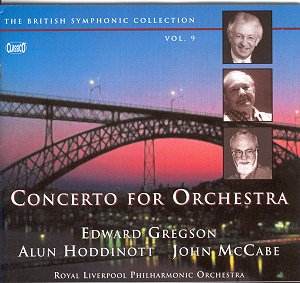These pieces were all written during the early 1980s.
They are all, in one way or another, works of orchestral display by
three composers whose orchestral mastery is well known, although each
of them has his own personal approach to the form.
Edward Gregson’s Contrasts was written
for the National Centre for Orchestral Studies and originally bore the
title Greenwich Dances. The piece was slightly revised
some time later with a change of title (Contrasts actually refers
to the variation-based structure of the piece). Further revisions were
made for the present recording. It is in three substantial movements
of which the central Elegy is the emotional heart, as the composer
rightly puts it. The first movement, Intrada, opens with a bold
four-note motto which will reappear several times later and, quite logically,
will be forcefully restated at the end of the third movement, Toccata.
This is a magnificent, colourful work full of invention in which Gregson’s
orchestral flair is evident from first to last.
Alun Hoddinott’s Concerto for Orchestra Op.127
(1986) is full of the composer’s fingerprints including bold angular
themes in the outer movements. There is beautifully atmospheric night
music in the slow movement. Deft and sparing use is made of the very
large percussion section including a number of unusual instruments.
Remarkable orchestral mastery is employed here. In the interview with
Lewis Foreman [track 16], Hoddinott tells us that the opening rhythmic
motif was suggested to him by the cooing of a pair of doves heard in
his garden. This rhythmic phrase and parts of the opening themes are
restated, sometimes with variations, all through the piece. This enhances
the coherence of the material.
John McCabe’s Concerto for Orchestra
(1982) is a quite substantial piece of music of symphonic proportions
and argument. To a certain extent, this is the most structurally complex,
intricately developed piece here. The composer describes its structure
as an enlarged passacaglia. It opens with bright, jubilant fanfares
leading into a long Adagio. This is followed by several shorter
"character" pieces, three of which obliquely refer to Schumann’s
Faschingsschwank aus Wien. The large-scale, multi-section
Finale builds towards mighty sound waves slowly fading into an ostinato
(referred to by the composer as "tape-loop") which lightly
tiptoes away. A great piece by all counts, and a worthy companion to
McCabe’s symphonies.
The last track is of an interview of the three composers
by Lewis Foreman. Significantly enough, all three insist on the communicative
qualities of their music and of music in general.
These three substantial, superbly written works here
receiving wonderful, dedicated performances, DO communicate, and each
of them represents its composer at his very best. Not to be missed.
Hubert Culot
The
British Symphonic Collection


